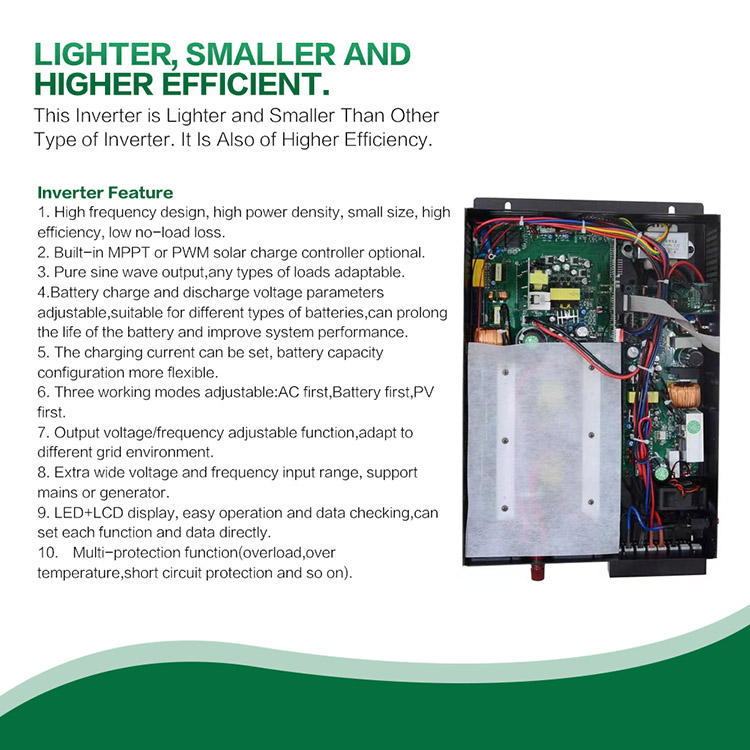Do you know these 6 major solar inverter failures? Solar Inverter Troubleshooting
 Aug 05,2022
Aug 05,2022

 Rekesun
Rekesun
Solar inverters are commonly used electronic devices, and in the electronics industry, solar inverters are even more popular. For solar inverters, the editor also introduced them in previous articles. The basic concepts of solar inverters, single-phase solar inverters, grid-connected solar inverters, etc., are all introduced by the editor. In order to improve everyone's understanding of solar inverters, this article will explain the common faults of solar inverters.
1. What is a solar inverter
The solar inverter is a converter that converts DC power (battery, storage battery) into constant frequency and constant voltage or frequency modulation and voltage regulation AC power (usually 220V, 50Hz sine wave). It consists of inverter bridge, control logic and filter circuit. Widely used in air conditioners, home theaters, electric grinding wheels, electric tools, sewing machines, DVDs, VCDs, computers, TVs, washing machines, range hoods, refrigerators, video recorders, massagers, fans, lighting, etc. In foreign countries, due to the high popularity of automobiles, you can use solar inverters to connect batteries to drive electrical appliances and various tools when you go out to work or travel. The on-board inverter output through the cigarette lighter is 20W, 40W, 80W, 120W to 150W power specifications. Some larger power inverter power supply should be connected to the battery through the connecting wire. Connecting home appliances to the output of the power converter enables a variety of appliances to be used in the car. Electrical appliances that can be used include: mobile phones, notebook computers, digital cameras, cameras, lighting, electric shavers, CD players, game consoles, PDAs, power tools, car refrigerators and various travel, camping, medical emergency appliances Wait. The solar inverter itself also consumes a part of the power when it is working, so its input power is greater than its output power. The efficiency of the solar inverter is the ratio of the output power of the solar inverter to the input power, that is, the efficiency of the solar inverter is the ratio of the output power to the input power. If a solar inverter inputs 100 watts of direct current and outputs 90 watts of alternating current, then its efficiency is 90%.

2. Common faults of solar inverters
Low insulation resistance
Use exclusion. Unplug all the strings on the input side of the solar inverter, and then connect them one by one. Use the function of the solar inverter to start up to detect the insulation resistance to detect the faulty strings. After finding the faulty strings, check whether the DC connectors are short of water. Connect the bracket or burn the short-circuit bracket. In addition, you can also check whether the component itself has black spots burned on the edge, which causes the component to leak electricity to the ground grid through the frame.
low bus voltage
If it occurs in the morning/evening period, it is a normal problem, because the solar inverter is trying the limit power generation conditions. If it occurs in normal daytime, the detection method is still the exclusion method, and the detection method is the same as item 1.
Leakage current fault
If the leakage current is too large, remove the input terminal of the PV array, then check the peripheral AC power grid, disconnect the DC terminal and the AC terminal, and let the solar inverter power off for 30 minutes. Contact a professional engineer.
DC overvoltage protection
With the pursuit of high-efficiency process improvement of components, the power level is constantly updated and increased, and the open-circuit voltage and operating voltage of components are also rising. The temperature coefficient problem must be considered in the design stage to avoid hard damage to the equipment caused by overvoltage at low temperature.
The solar inverter does not respond when turned on
Please make sure that the DC input line is not reversed. Generally, the DC connector has a foolproof effect, but the crimping terminal has no foolproof effect. It is very important to read the solar inverter manual carefully to ensure that the positive and negative poles are crimped. The solar inverter has built-in reverse short-circuit protection, and starts normally after normal wiring is restored.
grid failure
The work of early-stage investigation of heavy load (large working time of electricity consumption)/light load (less rest time of electricity consumption) of the power grid is reflected here, and the health of the voltage at the grid connection point is investigated in advance, and the grid situation is communicated with the solar inverter manufacturer. The combination of technologies can ensure that the project design is within a reasonable range, especially in rural power grids. Solar inverters have strict requirements on grid-connected voltage, grid-connected waveform, and grid-connected distance. Most of the grid overvoltage problems are caused by the original grid. The light-load voltage exceeds or is close to the safety protection value. If the grid-connected line is too long or the crimping is not good, the line impedance/inductive reactance is too large, and the power station cannot operate normally and stably.



 Home
Home What kind of inverter should be selected for household appliances?
What kind of inverter should be selected for household appliances? 







 syplighting.en.alibaba.com
syplighting.en.alibaba.com



